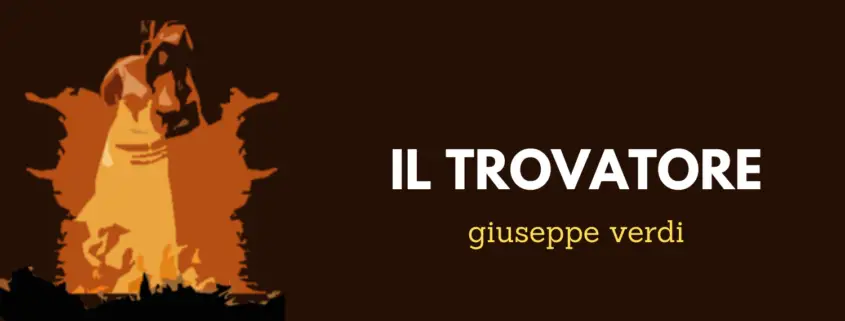The Portrait of Verdi’s Aria STRIDE LA VAMPA
Read Interesting facts and hear great YouTube Videos about the famous Aria “Stride la vampa”.
If you want to hear more about the opera Il Trovatore, click on the link to the opera portrait
The aria – synopsis and background
Synopsis: In the gypsy camp in the mountains. Azucena sits at the campfire and her thoughts glide to the pyre where her mother had to die. Azucena is still obsessed with her goal to avenge her mother.
Azucena is the Trovatore’s pivotal role. Her mood and inner drama are constantly changing, the libretto assigns her tragic and moving scenes: she is both a loving mother and a woman eaten away by vindictiveness. Verdi describes these conditions brilliantly, so the demands on this role are considerable. In “Stride la vampa”, for instance, she must master great Belcanto skills, with ornaments especially in the final part.
Azucena sings this aria in the shimmering light of the crackling and flickering fire. The greatest challenge of this aria is to create this mood, whose madness increases as the aria progresses. The aria must be sung like a hallucination. The tempo must be maintained to emphasize the manic aspect of this aria. The mood of the Azucena is marked by the bitterness of her feelings. Her memories of “urli di gioia” and “cinta di sgherri” (shouts of joy; surrounded by killers) are thrown out shaken by hatred. The crackling of the fire and the flickering of the fire are drawn in the orchestral accompaniment with dotted rhythms and taken up by the singer and run through the entire aria. In “Sinistra splende sui volti orribili” (Evil shines upon horrible faces) her voice shudders. The aria reaches the climax of the first part with “La tetra fiamma che s’alza al ciel (the gloomy flame that rises to the sky).
The second part music is equally arranged. Now her mother appears before her mind’s eye before the stake and the “Grido feroce di morte levasi” (A fierce shout of death arises) sung in the hollow piano makes the blood freeze in your veins. With a last long shudder (a long trill) the aria of Azucena ends.
The Aria – the text of Stride la vampa
Stride la vampa!
La folla indomita corre a quel fuoco
lieta in sembianza;
urli di gioia intorno echeggiano:
cinta di sgherri donna s’ avanza!
Sinistra splende sui volti orribili
la tetra fiamma che s’alza al ciel!
Stride la vampa!
giunge la vittima nerovestita,
discinta e scalza!
Grido feroce di morte levasi;
l’ eco il ripete di balza in balza!
Sinistra splende sui volti orribili
la tetra fiamma che s’alza al ciel!
Vocal Fach «Dramatic mezzosoprano»
The role of Azucena is written for a dramatic mezzosoprano. The dramatic mezzosoprano must have a strong, voluminous voice. The demand for vocal creativity is high, which is why these roles are usually entrusted to vocally mature and experienced singers. The role requires a high resilience and endurance of the singer.
Famous interpretations of STRIDE LA VAMPA
In recording history there have been many outstanding Azucena’s such as Giulietta Simionato, Fedora Barbieri, Marilyn Horne or Fiorenza Cossotto.
From Fiorenza Cossotto we hear a brilliant but rather distanced Azucena.
Stride la vampa – Cossotto
Fedora Barbieri presents us a captivating/dramatic Azucena.
Stride la vampa – Barbieri
Marylin Horne has been attested by many that her technique has hardly been surpassed by any singer of the twentieth century. The range, regularity and agility of the voice was almost unmatched. Thus she celebrated her greatest successes especially in the coloratura-heavy genre of Rossini.
Stride la vampa – Horne
As the last interpretation you will hear Giulieta Simionato with a brighter voice than the previous ones. She was one of those singers whose stage magic was greater than we can hear on the recording today. She celebrated great triumphs in the fifties, among others with this role in Salzburg.
Stride la vampa – Simonato
Here you can watch a TV Production from the met.
Stride la vampa
Peter Lutz, opera-inside, the online opera guide to the Aria “Stride la vampa” from the opera Il trovatore.



Gut gemacht. Textübersetzung der Arie wäre super…
Well done.